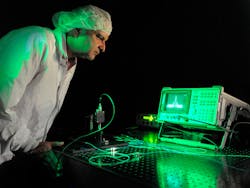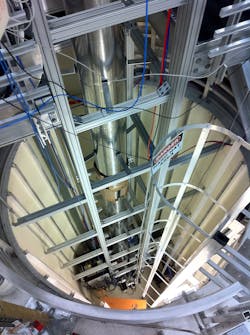Atom optics and interferometry to advance with NASA and AOSense funding
Greenbelt, MD--The NASA Innovative Advanced Concepts (NIAC) program has awarded funding to a team of researchers at NASA's Goddard Space Flight Center, Stanford University (Stanford, CA), and AOSense (Sunnyvale, CA) to advance atom-optics technologies. Some believe this emerging, highly precise measurement technology is a technological panacea for everything from measuring gravitational waves to steering submarines and airplanes. "I've been following this technology for a decade," said Bernie Seery, a Goddard executive who was instrumental in establishing Goddard's strategic partnership with Stanford University and AOSense two years ago. "The technology has come of age and I'm delighted NASA has chosen this effort for a NIAC award," he said.
The NIAC program supports potentially revolutionary, high-risk technologies and mission concepts that could advance NASA's objectives. Seery added that the U.S. military has invested heavily in the technology to dramatically improve navigation. Although the researchers believe the technology offers great promise for a variety of space applications, including navigating around a near-Earth asteroid to measure its gravitational field and deduce its composition, so far they have focused their efforts on using Goddard and NASA Research and Development seed funding to advance sensors that could detect theoretically predicted gravitational waves.
Predicted by Albert Einstein's general theory of relativity, gravitational waves occur when massive celestial objects move and disrupt the fabric of space-time around them. By the time these waves reach Earth, they are so weak that the planet expands and contracts less than an atom in response. This makes their detection with ground-based equipment more challenging because environmental noise, like ocean tides and earthquakes, can easily swamp their faint murmurings. Although astrophysical observations have implied their existence, no instrument or observatory, including the ground-based Laser Interferometer Gravitational-Wave Observatory, has ever directly detected them.
Atom interferometry works much like optical interferometry, obtaining measurements by comparing light that has been split into two equal halves with a device called a beamsplitter. Because the path that one beam travels is fixed in length and the other travels an extra distance or in some other slightly different way, the two light beams overlap and interfere when they meet up, creating an interference pattern that scientists inspect to obtain highly precise measurements. Atom interferometry, however, hinges on quantum mechanics, the theory that describes how matter behaves at sub-microscopic scales. Just as waves of light can act like particles called photons, atoms can be cajoled into acting like waves if cooled to near absolute zero. At those frigid temperatures, which scientists achieve by firing a laser at the atom, its velocity slows to nearly zero. By firing another series of laser pulses at laser-cooled atoms, scientists put them into what they call a "superposition of states." now being developed to detect what so far has remained imperceptible: gravitational waves or ripples in space-time caused by cataclysmic In other words, the atoms have different momenta permitting them to separate spatially and be manipulated to fly along different trajectories. Eventually, they cross paths and recombine at the detector—just as in a conventional interferometer. "Atoms have a way of being in two places at once, making it analogous to light interferometry," said Mark Kasevich, a Stanford University professor and team member credited with pushing the frontiers of atom optics.
Since joining forces, the team has designed a powerful, narrowband fiber-optic laser system that it plans to test at one of the world's largest atom interferometers—a 33-foot drop tower in the basement of a Stanford University physics laboratory. During the test, the team will insert a cloud of neutral rubidium atoms inside the 33-foot tower. As gravity asserts a pull on the cloud and the atoms begin to fall, the team will use its new laser system to fire pulses of light to cool them. Once in the wave-like state, the atoms will encounter another round of laser pulses that allow them to separate spatially. Their trajectories then can be manipulated so that their paths cross at the detector, creating the interference pattern.The team also is fine-tuning a gravitational-wave mission concept it has formulated. Similar to the Laser Interferometer Space Antenna (LISA), the concept calls for three identically equipped spacecraft placed in a triangle-shaped configuration. Unlike LISA, however, the spacecraft would come equipped with atom interferometers and they would orbit much closer to one another—between 500 and 5000 km apart, compared with LISA's five-million-km separation. Should a gravitational wave roll past, the interferometers would be able to sense the miniscule movement.
"I believe this technology will eventually work in space," Kasevich said. "But it presents a really complicated systems challenge that goes beyond our expertise. We really want to fly in space, but how do you fit this technology onto a satellite? Having something work in space is different than the measurements we take on Earth." That's where Goddard comes in, Saif said. "We have experience with everything except the atom part," he said, adding that AOSense already employs a team of more than 30 physicists and engineers focused on building compact, ruggedized atom-optics instruments. "We can do the systems design; we can do the laser. We're spacecraft people. What we shouldn't be doing is reinventing the atomic physics. That's our partners' forte."
SOURCE: NASA; www.nasa.gov/topics/technology/features/atom-optics.html

Gail Overton | Senior Editor (2004-2020)
Gail has more than 30 years of engineering, marketing, product management, and editorial experience in the photonics and optical communications industry. Before joining the staff at Laser Focus World in 2004, she held many product management and product marketing roles in the fiber-optics industry, most notably at Hughes (El Segundo, CA), GTE Labs (Waltham, MA), Corning (Corning, NY), Photon Kinetics (Beaverton, OR), and Newport Corporation (Irvine, CA). During her marketing career, Gail published articles in WDM Solutions and Sensors magazine and traveled internationally to conduct product and sales training. Gail received her BS degree in physics, with an emphasis in optics, from San Diego State University in San Diego, CA in May 1986.

